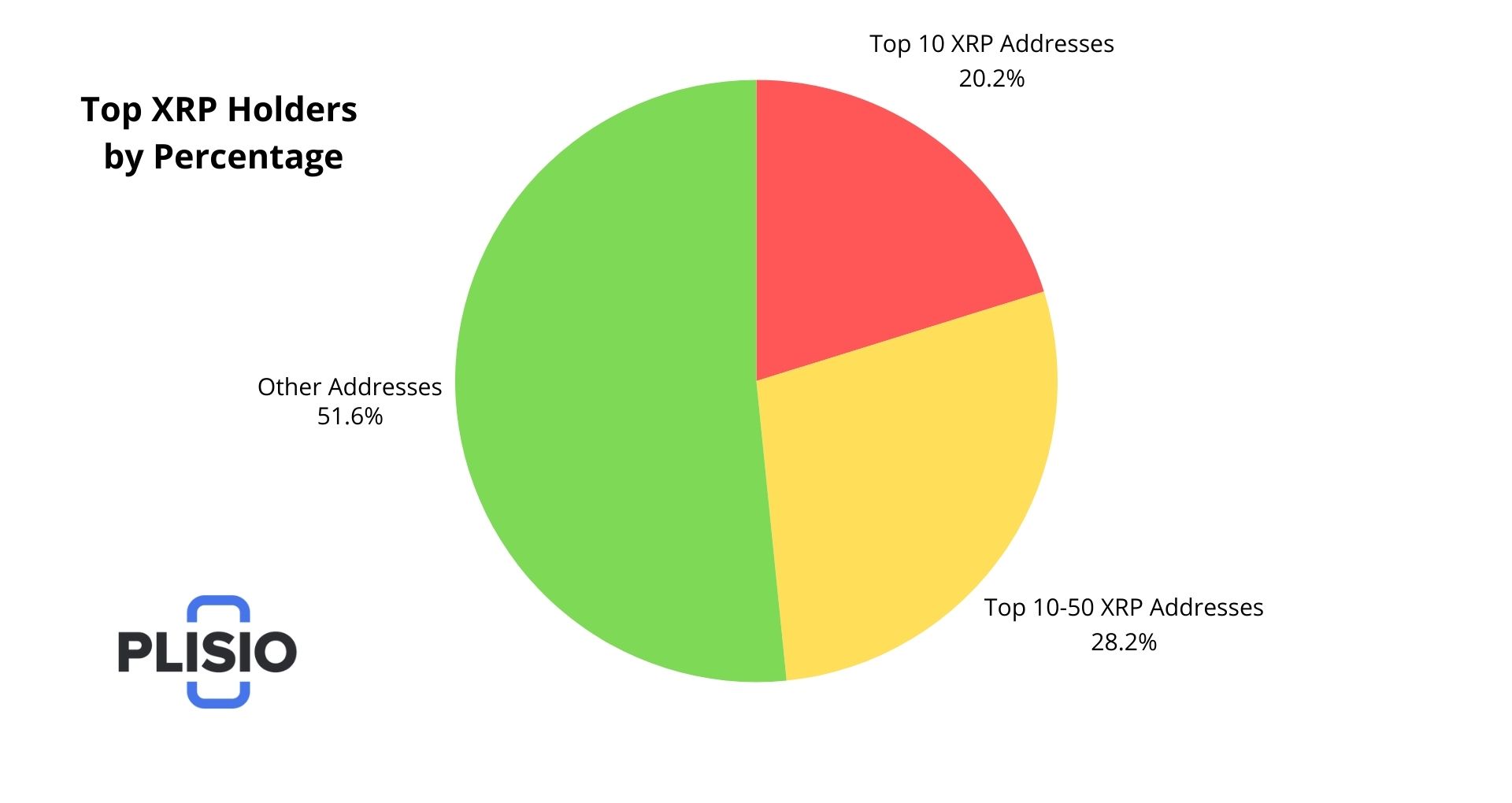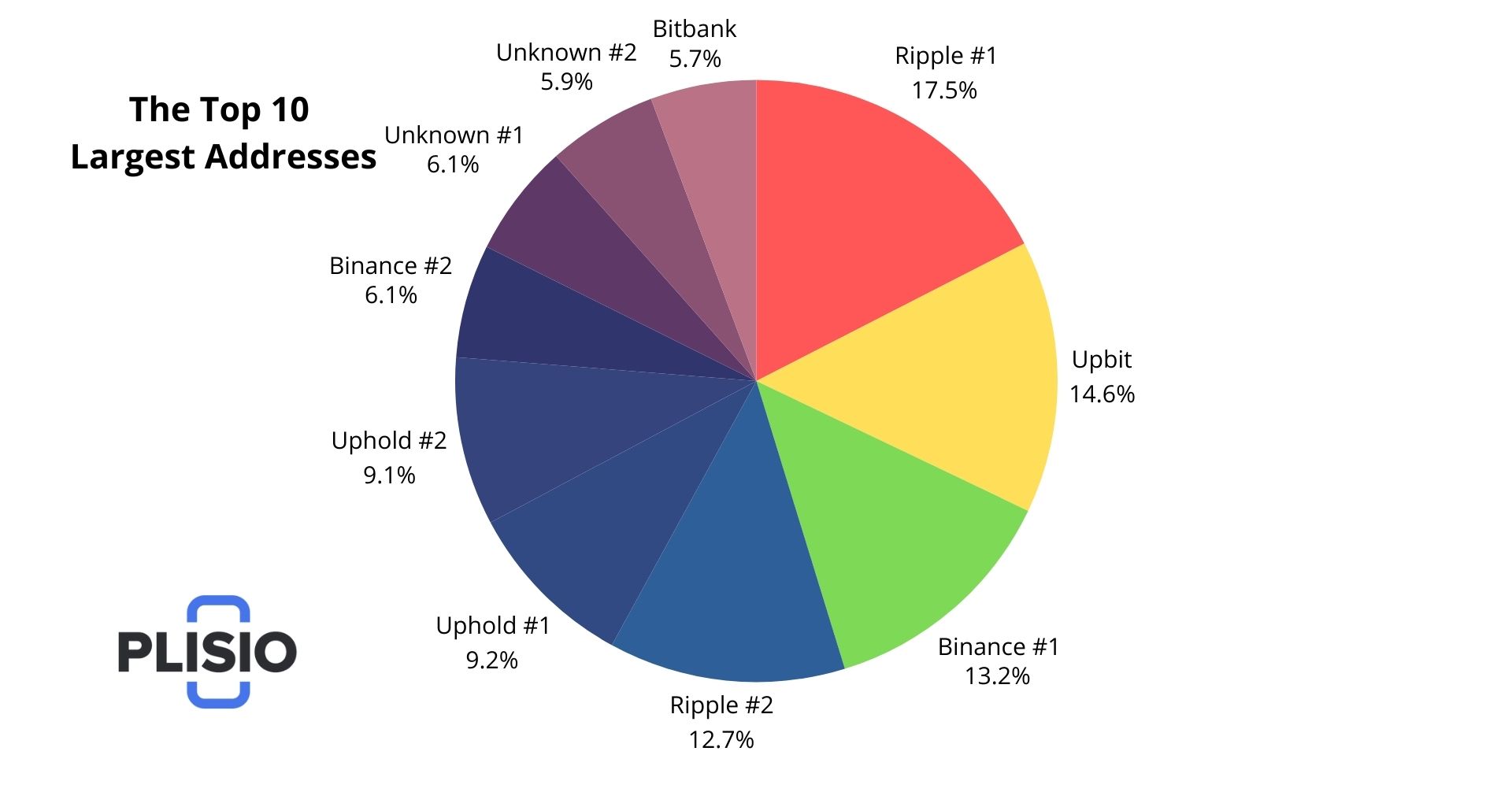XRP Rich List: Top 10 Ripple Holders

As of 2024, Ripple and its founders, alongside several major cryptocurrency exchanges, continue to dominate the top spots on the XRP rich list, highlighting a significant concentration of wealth within the Ripple Network. Currently, the top 10 wealthiest addresses control 20.22% of XRP's total circulating supply. Addresses ranked 11th to 50th hold another 28.16%, leaving the vast majority of addresses, those beyond the top 50, with 51.62% of the circulating coins.
XRP remains one of the heavyweight digital assets by market valuation, boasting a capitalization exceeding $27 billion. Despite a historical decline in price due to ongoing legal challenges, notably the SEC lawsuit, the asset's broad ownership base remains optimistic. Out of a capped total of 100 billion XRP coins, approximately 55.57 billion are currently active in circulation.
On-chain data reveals the financial stakes involved, with the top 10 holders alone controlling over 11 billion XRP coins, equivalent to a value of $6.8 billion. Meanwhile, the next 40 largest holders collectively manage coins worth approximately $10.4 billion, culminating in about $17.2 billion controlled by the top 50 addresses.
This overview not only illustrates the current state of XRP distribution but also serves as a crucial indicator of the market dynamics and investor sentiment surrounding one of the world's most controversial yet popular cryptocurrencies. This concentration of ownership underscores the significant stakes held by the largest holders and the centralized nature of XRP ownership.
XRP Rich List: Who Is In It?
In 2024, the distribution of XRP coins continues to show a significant concentration among certain key holders. Prominent figures such as Ripple's founders, Chris Larsen and Brad Garlinghouse, along with major centralized exchanges including Binance, Uphold, and Bitbank, dominate the XRP rich list. These entities are among the top holders, possessing vast amounts of XRP, often held across multiple addresses and representing holdings worth hundreds of millions of dollars.
Centralized exchanges primarily hold XRP in reserves as deposits from their customers, explaining why entities like Binance command one of the largest XRP pools. The BNB Chain is particularly notable for its concentrated XRP holdings; the top 10 addresses there contain 168 million XRP, accounting for over 57% of the coin's BEP20 variety. Yet, despite these substantial numbers, XRP's presence on the BNB Chain is relatively minor when considering the total circulation of the token.
As of March 2024, there are approximately 54.88 billion XRP in circulation, with a market capitalization of $33.7 billion. The distribution among the top addresses is revealing:
- The top 10 XRP addresses hold 11.1 billion XRP, which equates to 20.24% of the circulating supply.
- The next 40 addresses (top 11-50) control 15.65 billion XRP, representing 28.51% of the circulation.
- The remaining addresses, numbering over 4.8 million, share 28.12 billion XRP or 51.24% of the total circulating supply.
This data underscores a nearly even split between the largest holders and the broader XRP community, highlighting a centralization of wealth at the top, with the vast majority of addresses holding a smaller fraction of the supply. Such a distribution pattern points to both the centralized nature of XRP ownership and the broad base of smaller investors who collectively wield a significant portion of the circulating tokens. This balance is critical for understanding the market dynamics and investor sentiment that continue to shape the XRP ecosystem.

XRP Rich List: The 10 Top Addresses
In 2024, the XRP ecosystem exhibits significant centralization in terms of coin ownership, with the largest wallets predominantly held by institutional players and Ripple itself. As of mid-June, the top 10 addresses control approximately 11.2 billion XRP, valued at around $5.52 billion. This concentration highlights the substantial portion of the circulating supply controlled by a small number of entities.
The detailed list below outlines the major holders and their corresponding shares:
- Ripple #1: Holds 1,960,027,080 XRP (3.53% of circulating supply). Address: rMQ98K56yXJbDGv49ZSmW51sLn94Xe1mu1
- Upbit: Controls 1,647,573,414 XRP (2.96%). Address: rDxJNbV23mu9xsWoQHoBqZQvc77YcbJXwb
- Binance #1: Owns 1,477,168,712 XRP (2.66%). Address: rEy8TFcrAPvhpKrwyrscNYyqBGUkE9hKaJ
- Ripple #2: Holds 1,427,544,084 XRP (2.57%). Address: rKveEyR1SrkWbJX214xcfH43ZsoGMb3PEv
- Uphold #1: Manages 1,037,765,929 XRP (1.87%). Address: rBEc94rUFfLfTDwwGN7rQGBHc883c2QHhx
- Uphold #2: Controls 1,015,183,383 XRP (1.83%). Address: rsX8cp4aj9grKVD9V1K2ouUBXgYsjgUtBL
- Binance #2: Owns 685,771,434 XRP (1.23%). Address: rs8ZPbYqgecRcDzQpJYAMhSxSi5htsjnza
- Unknown #1: Holds 685,476,395 XRP (1.23%). Address: rEvwSpejhGTbdAXbxRTpGAzPBQkBRZxN5s
- Unknown #2: Controls 660,927,537 XRP (1.19%). Address: r99QSej32nAcjQAri65vE5ZXjw6xpUQ2Eh
- Bitbank: Owns 640,354,319 XRP (1.15%). Address: rw7m3CtVHwGSdhFjV4MyJozmZJv3DYQnsA
This list underlines the role of exchanges in the XRP market, with Ripple's own wallets also prominently featured. The ownership landscape is dominated by these major entities, reflecting a mix of institutional and corporate control over the circulating XRP.

The impact of non-circulating supply is notable, with about 45 billion XRP (of the total 100 billion) either vested or in escrow, primarily in Ripple-controlled wallets. This portion of the supply, if considered, would dramatically shift the composition of the rich list, with Ripple's holdings dominating even more. This centralized pattern of ownership raises important questions about market influence and control, particularly how Ripple and major exchanges can impact XRP's liquidity and price stability. Understanding these dynamics will be crucial for both investors and regulators as the ecosystem evolves.
Ripple Founders and Their XRP Holdings: An Update
Since Ripple's inception, founders Chris Larsen, Jed McCaleb, and Arthur Brito initially allocated a substantial 20 billion XRP to themselves. Over the years, their handling of these assets has diverged significantly. Jed McCaleb, who departed Ripple in 2014, took with him 9 billion XRP. It took him eight years to completely liquidate his holdings, a process he completed only recently.
In contrast, the remaining co-founders, including Chris Larsen, have retained a significant portion of their XRP. Larsen, in particular, still commands one of the largest known caches of XRP, with Forbes citing his holdings at over 5 billion XRP. Directly traceable addresses linked to Larsen account for approximately 2.5 billion of these tokens. Meanwhile, current CEO Brad Garlinghouse is also reported to be among the top holders, although detailed figures on his holdings are not publicly disclosed.
The reluctance of Larsen and other co-founders to sell their XRP can be attributed to ongoing legal scrutiny. The U.S. Securities and Exchange Commission (SEC) has been engaged in a prolonged legal battle with Ripple, alleging that XRP constitutes an unregistered security. This unresolved case has had significant repercussions, not only limiting the co-founders' ability to freely trade their holdings without potential legal consequences but also influencing U.S.-based cryptocurrency exchanges to delist XRP, thereby reducing its liquidity and trading venues in the domestic market.
The situation is further complicated by the broader regulatory environment for cryptocurrencies in the U.S., where the classification of digital assets remains a contentious and evolving issue. This regulatory uncertainty underscores the complex interplay between innovation in the blockchain sector and traditional financial regulations. The outcome of Ripple's legal challenges could set important precedents for the treatment of other cryptocurrencies under U.S. law.
XRP Compares With BTC, ETH And Other Popular Cryptocurrencies.
The concentration of wealth in the cryptocurrency market varies significantly among different digital assets. XRP, Bitcoin, Ethereum, Dogecoin, Solana, and Cardano each demonstrate unique patterns of ownership that influence market dynamics and potential vulnerabilities to manipulation.
XRP Whales
XRP exhibits a high degree of centralization, with the top 10 addresses holding 20.2% of its circulating supply. A total of 28 addresses control over 20.3 billion XRP, representing 37.3% of all coins in circulation. This centralization is indicative of XRP's corporate-backed structure and contrasts with more decentralized networks.
Bitcoin Whales
Bitcoin's ownership is more dispersed compared to XRP, with only 5.3% of the supply held by the top 10 addresses. The largest Bitcoin wallets include four addresses holding over 100,000 BTC, contributing to about 7.7 million BTC or 40% of the circulating supply, spread across various holders, indicating a relatively decentralized distribution.
Ethereum Whales
Ethereum's ecosystem shows a substantial portion of Ether being staked or held in contracts. Approximately 35.6% of Ether is locked in staking contracts, and 3% is in Wrapped Ether contracts. The top 100 Ethereum addresses control 41.5% of the supply, with 1200 addresses holding at least 10,000 ETH each, accounting for over 70% of the total supply, pointing to significant institutional involvement.
Dogecoin Whales
Dogecoin displays a significant concentration of supply within exchanges. The top 100 DOGE addresses hold 66% of the circulating supply, primarily within large exchange wallets, reflecting its popular use for speculative trading rather than utility.
Solana Whales
Solana shows a relatively moderate concentration of wealth, with the top 100 holders possessing 33.29% of the supply. The top 10 addresses alone hold 10.78%, with the largest wallet containing 16.87 million SOL, suggesting a blend of both retail and institutional interest.
Cardano Whales
Cardano stands out for its less concentrated wealth distribution, with the top 10 holders controlling just 6.41% of the circulating supply. The top 100 wallets hold 18.97%, making ADA's ownership less top-heavy compared to other major cryptocurrencies like XRP or Ethereum.
Conclusion
As we approach the midpoint of 2024, the distribution of XRP's circulating supply offers a nuanced perspective on decentralization within the cryptocurrency market. The top 10 addresses on the XRP rich list hold a significant 20.2% of all circulating coins, underscoring a concentration that is notable but not uncommon in the digital asset space. By contrast, the top 20 XRP addresses together control nearly 30% of the supply, a figure that includes several large cryptocurrency exchanges and firms managing assets on behalf of retail investors.
This centralized control in XRP, however, presents a different picture when compared to other leading cryptocurrencies. Bitcoin, for example, exhibits a higher degree of decentralization with its top 10 addresses holding only 5.7% of the total circulating supply. In stark contrast, Ethereum and Dogecoin show much greater centralization, with the top 10 addresses controlling 34.7% and 46.6% of their respective supplies.
Despite these figures, XRP's concentration among a few top addresses—mostly institutional and exchange-related—does not necessarily imply that XRP is less decentralized overall. Many of these addresses are custodial, holding XRP for a myriad of individual investors, thereby dispersing the effective control across a broader user base. This factor contributes to XRP's resilience and distribution metrics, positioning it as one of the more balanced projects in terms of ownership concentration among major cryptocurrencies.
Moreover, XRP continues to stand out as a promising altcoin project, driven by its clear focus on solving real-world financial problems and fostering partnerships with established companies. This strategic positioning not only enhances XRP's use case but also its visibility and potential for widespread adoption.
In summary, while the distribution of XRP's supply does feature significant centralization at the top, the overall landscape shows a mix of institutional and retail holdings that help mitigate some of the risks typically associated with high concentration levels. This distribution, alongside its robust project fundamentals, underscores XRP's role as a key player in the broader crypto ecosystem
